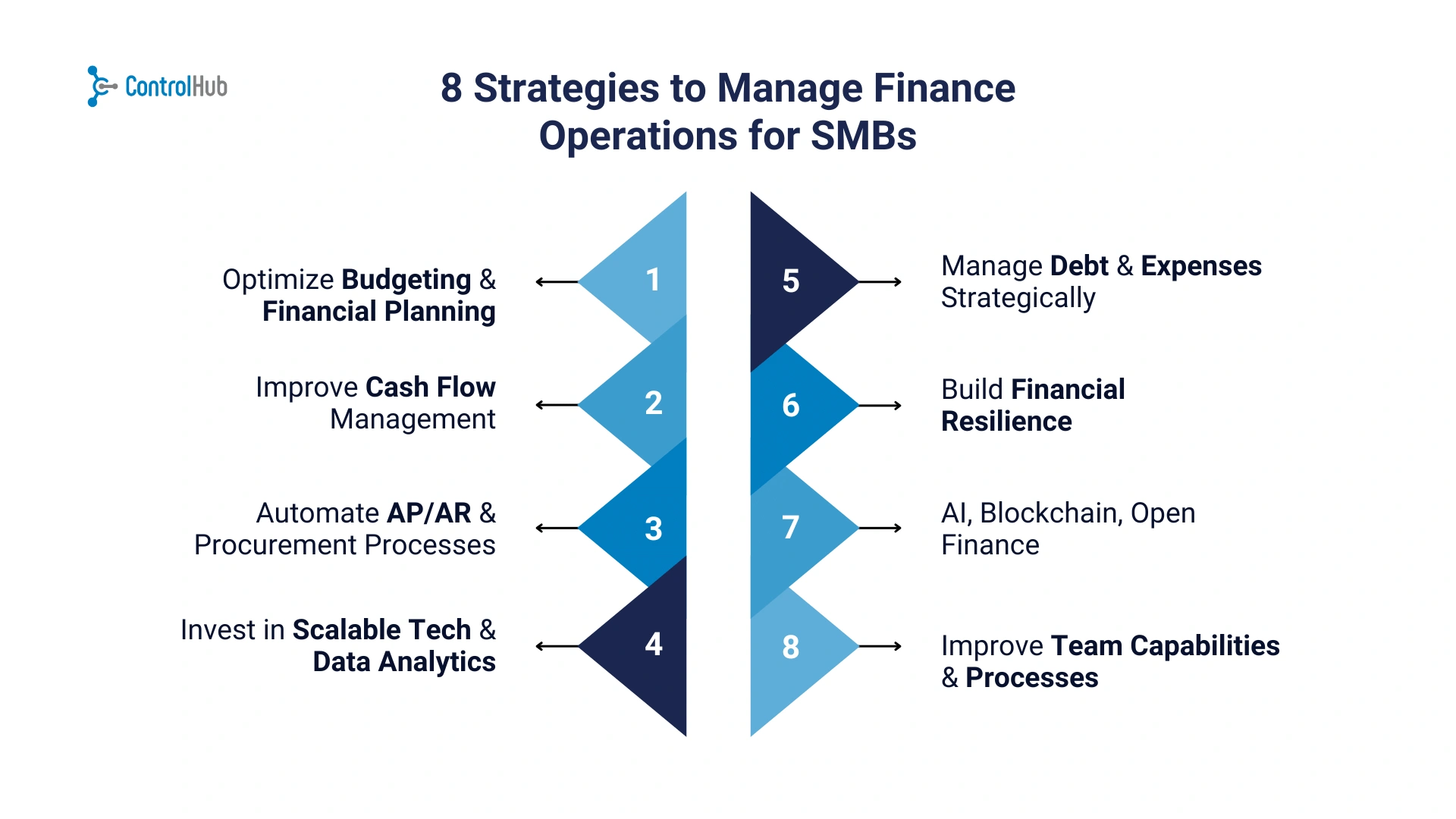Free Supplier Risk Scorecard Download
Download our free supplier risk scorecard here!
Download the free tool!AI Summarize:
Here's a sad fact
Roughly 50% of new businesses fail within five years
The biggest problem for a huge majority of those failure cases?
Cash flow
Suddenly, it doesn't matter how great your product is or how much you work; you just don't see a way around your business's poor finances.
Depressing, right?
Well, it's nothing that cannot be prevented by implementing some good financial strategies.
Like the ones we are listing below
What are Financial Operations?
FinOps are and should be every business’s best friend.
They are the behind-the-scenes processes keeping your company's resources flowing with zero issues.
It's the system with which you know where your money is going and why.
Put it this way: Without a clear picture of your financial operations, any decision you make about the future of your business is going to be exposed to a lot of risk and uncertainty.
Among the most common financial operations out there, you'll find these ones:
- Budgeting and forecasting: Planning how much you’ll earn and spend, giving you the opportunity to adjust as things change.
- Accounts payable (AP) and receivable (AR): Paying your bills on time and making sure customers pay you on time, too, is a critical component of having a healthy cash flow.
- Cash flow management: And speaking about money, keeping enough cash on hand to cover daily operations without running into surprises is extremely important.
- Expense tracking: Monitoring what you spend, where, and why, makes it natural to spot savings and avoid risks
- Procurement and supplier management: Be ready to make efficient purchases for your business.
- Reporting and compliance: Making sure your financial records are accurate, up to date, and ready for tax season or audits.
8 Strategies to Manage Finance Operations for SMBs
Optimize budgeting & financial planning.
Many new business leaders create a budget when they're at a starting point, as part of their business plan.
Because it's a requirement
The problem?
We tend to forget about those things
And that's how you start having nightmares about your company's finances.
Planning a budget for the very early stages of a business is great, but once you're already up and running, you must be constantly aware of what's happening with those numbers.
Break down your expenses into categories like payroll, marketing, software, and supplies.
Don’t make random calculations; check into past spending patterns to set realistic numbers.
If you’re unsure where to start, even a simple spreadsheet based on last year’s data is a smart idea.
In a world that's changing by the minute, you also need to care about the future.
And that's what forecasting exists for
Financial forecasting goes beyond budgeting, as it predicts what your future financial situation will look like based on sales trends, seasonality, market changes, or even geopolitical events.
Tips to improve your budgeting and forecasting:
- Set aside time each month to review your budget vs. actuals, be prepared to change if needed. Which…can happen more often than not.
- Use cloud-based budgeting tools like Float, LivePlan, or QuickBooks to visualize your numbers.
- Collaboration is key for success, having a chat with your team members is a good start, and budgeting works better when the people spending the money are part of the planning process.
- Build in some buffer for unexpected costs, because, well, surprises happen, especially in SMB life.
Improve cash flow management
Ah, money…
Isn't it at the core of our happiness?
Not exactly, but it certainly makes life easier, and if you are in charge of a small or medium-sized business, easy means happiness.
Picture that you are selling all of your products and feeling ready to make important partnerships, but one look at your books and the situation tells a different story.
What could possibly be wrong?
You don't have sufficient cash liquidity.
In simpler words, you aren't managing your cash correctly.
You want to know what’s coming in, what’s going out, and when. Working with a spend management software can help you to monitor the money in real-time, but beyond that, here's a list of things you can do to optimize your cash flow.
Tips to optimize your cash flow management:
- Invoice as soon as possible, don’t wait until the end of the week or month. You offered a product or service; it's time to get rewarded for that.
- Offer early payment incentives to customers who pay quickly. It's a practice that benefits everyone involved.
- Follow up on overdue invoices with polite reminders and clear due dates. You can automate this part.
- Make payments easier by offering online payment options.
- Take full advantage of supplier payment terms without risking late fees.
- Negotiate better terms with key suppliers, for example, net-45 or net-60, which can free up cash.
- Schedule payments in batches to improve control and avoid missed due dates.
So yes, it's definitely possible to have the money ready when your business needs it.
But you've to work on that to make it happen
Gather your data, be proactive, and automate whenever possible.
Automate AP/AR & Procurement Processes
Do you know what's worse than a missing invoice?
A supplier disappointed with your company.
Maybe it was you who had to get paid, but there's no record of it anywhere.
Manual processes are usually the main culprit.
Like we always say, Excel is great…until it's not.
Automating key financial operations like Accounts Payable or Accounts Receivable won't just reduce the time you spend chasing incomplete processes, but it'd also contribute to a healthier financial situation for your company.
Things you can do with automation:
- Automatically generate and send invoices the moment a sale closes.
- Set up payment reminders so customers get aware of it, without you lifting a finger.
- Auto-match invoices to purchase orders and receipts, which reduces errors and manual data entry. This is known as the 3-way matching process.
- Schedule vendor payments, ensuring you never miss a due date or accidentally pay too early, without the proper discount.
If you feel like automation might be too complex for your current business stage, remember that procurement and spend management software are becoming increasingly popular, so it won't take long until you find the solution that just matches your needs.
Invest in Scalable Tech & Data Analytics
Looking for procurement software or a financial digital system?
Make sure your choice is scalable.
You might be a small business right now, but that situation won't last forever. More often than not, success comes with expanding the reach of your market, and when that happens, you are going to need a digital service ready to grow along with you.
Above all?
You need a system that prevents problems, which takes us to highlighting the relevance of relying on data analytics.
Financial analytics can give you deep insights into what’s working and what’s not.
Tips to get started:
- Set up KPIs like gross margin, burn rate, DSO (days sales outstanding), or cash conversion cycle.
- Use dashboards to monitor trends over time, not just snapshots. This might come in handy for forecasting later on.
- Track budget vs. actuals monthly to course-correct quickly.
- Compare supplier pricing and identify spending inefficiencies.
Most modern finance tools come with built-in analytics so you can keep things simple and still get your numbers right.
Manage Debt & Expenses Strategically
To make money, you've to invest money first.
That's pretty much how the business world works, so while it's definitely more glamorous to talk about profit and revenue, you also must be in touch with your debts and expenses.
Regardless of their reputation, not all debt is bad; loans, for example, or lines of credit, and even credit cards, can be of great assistance for your business if managed well.
But if repayments are eating into your cash flow, it’s time to take a closer look. Ask yourself questions like: Are you paying high-interest rates that you could refinance?
Can you renegotiate terms for better payment flexibility? Are you using debt to invest in growth, or just to stay afloat?
The answer to this question makes all the difference.
How to manage your expenses better?
- Review subscriptions and recurring charges, you’d be surprised what sneaks through each month.
- Consolidate suppliers to gain better pricing or volume discounts.
- Compare costs across tools and services regularly to make sure you're getting the best deal.
- Set internal spending policies so teams know what’s okay to spend and what needs approval. Simple as it sounds, this step has a huge impact on your efforts to reduce maverick spending.
Build Financial Resilience
Nobody likes problems
But if you are in charge of a business, you know that those can happen without notice.
Preventing them is part of your strategy, of course, but having a sort of backup plan while things get back to normal.
We are talking about financial resilience.
That foundation on which you can rely during tough times.
It doesn’t have to happen overnight, even gradually setting aside a small percentage of revenue each month can help you big time, when it's needed.
It won't hurt to remember that for financial management to work in your favour, you need to align with reality.
AI, Blockchain, Open Finance
Because automation is everywhere.
Small and mid-sized businesses like yours can now enjoy the benefits of powerful tools that were once out of reach, thanks to emerging technologies like AI, blockchain, and open finance.
And the best part?
You don’t need to be a tech expert to take advantage of them.
Let’s start with AI. Many finance platforms now use AI and machine learning to automate reporting, detect unusual activity, and even tailor their mechanisms to your unique requirements.
This means:
- Faster monthly closes
- Real-time insights without hours of manual analysis
- Smarter predictions about cash flow, revenue, and expenses
Then there’s blockchain. While it’s true that it's more linked to large enterprises, blockchain has huge potential for areas like secure, tamper-proof transaction records, faster cross-border payments, and supplier transparency. All things that at some point will be relevant for your company.
Improve Team Capabilities & Processes
Do you want to know what the best strategy is?
Your team
Or rather, the effort you put into their development
Your engineers probably won't be fully familiar with all the ins and outs of financial management, but they definitely have to be in touch with the financial goals and policies of the business.
Free Supplier Risk Scorecard Download
Download our free supplier risk scorecard here!
Download the free tool!Free Supplier Risk Scorecard Download
Download our free supplier risk scorecard here!
Download the free tool!Free Supplier Risk Scorecard Download
Download our free supplier risk scorecard here!
Download the free tool!Free Supplier Risk Scorecard Download
Download our free supplier risk scorecard here!
Download the free tool!Key Takeaways
- Financial operations are the backbone of your business, covering everything from budgeting to payments, reporting, and planning.
- A strong budgeting and forecasting routine helps you stay agile and make smarter decisions as your business grows.
- Good cash flow management is about more than money in vs. money out; it’s about timing, visibility, and control.
- Automating AP, AR, and procurement saves time, reduces errors, and gives you real-time insight into your finances.
- Scalable finance tech and data analytics empower you to track KPIs, spot trends, and make better long-term decisions.
- Managing debt and expenses strategically keeps your business lean and financially healthy without cutting corners.
- Building financial resilience with cash reserves and long-term planning helps you navigate uncertainty with confidence.
- Emerging technologies like AI, blockchain, and open finance aren’t just buzzwords; they offer real, practical benefits for SMBs.
- Clear processes and a well-trained team are essential for maintaining smooth financial operations as you grow.
%20(1).avif)















.png)


